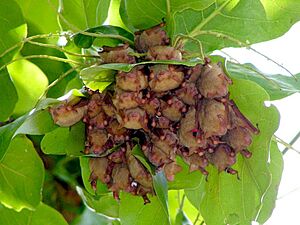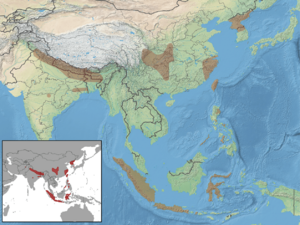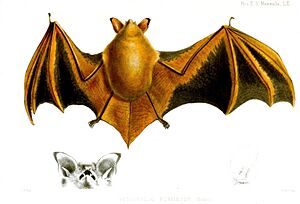Hodgson's bat facts for kids
Quick facts for kids Hodgson's bat |
|
|---|---|
 |
|
| Subspecies flavus in Taiwan | |
| Conservation status | |
| Scientific classification | |
 |
|
| Hodgson's bat range (includes M. rufoniger, M. rufopictus, M. weberi, and M. bartelsii) | |
| Synonyms | |
|
Myotis flavus Shamel, 1944 |
The Hodgson's bat (Myotis formosus) is also known as the copper-winged bat or black-and-orange myotis. It is a type of vesper bat from the Myotis group, also called mouse-eared bats. These bats love living in mountain forests. You can find them across Central, Southeast, and East Asia, from Afghanistan all the way to Taiwan. They are about 5 centimetres (2.0 in) long. You can easily tell them apart from other bats in their area because of their yellowish color.
Contents
How Scientists Study and Name Bats
For a long time, scientists thought that Hodgson's bat was just one species. They believed it lived in many places, from Central Asia to Taiwan, Korea, and Indonesia. But in 2014, a new study looked closely at how these bats looked. They found big differences between bats from different places.
Because of these differences, scientists decided to split Hodgson's bat into several separate species. The true Hodgson's bat (M. formosus) now lives from Central Asia to Taiwan. Other species include the reddish-black myotis (M. rufoniger), the orange-fingered myotis (M. rufopictus), Bartels's myotis (M. bartelsii), and Weber's myotis (M. weberi).
Scientists also found that Hodgson's bat is closely related to Geoffroy's bat and the Cape hairy bat. This means they share a common ancestor.
There was a subspecies called flavus found in Taiwan. Some thought it was a separate species. However, the 2014 study showed that M. flavus is still the same species as M. formosus. Most experts agree with this today.
What Does Hodgson's Bat Look Like?
An adult Hodgson's bat has a head and body that are about 4.3 to 5.7 centimetres (1.7 to 2.2 in) long. Its tail is about 3.6 to 5.6 centimetres (1.4 to 2.2 in) long. Their forearm, which is part of their wing, measures about 4.3 to 5.2 centimetres (1.7 to 2.0 in). These bats usually weigh around 15 grams (0.53 oz).
Their fur is short and thick. It has a much brighter yellow color than most other bats found in the same areas. This bright yellow color helps them stand out.
Where Do These Bats Live?
Hodgson's bat lives in many parts of Asia. You can find them in Afghanistan, Bangladesh, and many states in India. They also live in central and western Nepal, often in high places up to 3,000 metres (9,800 ft) (about 9,800 feet).
These bats are also found in eastern and central China and Taiwan. In Taiwan, they might live in the same areas as the reddish-black myotis. They live in both old and new forests, in high and low areas. They like to rest in caves and trees. Sometimes, they even roost in buildings.
Life Cycle and Habits
Hodgson's bats are insectivores, which means they eat insects. They find their food by using echolocation. This is like a natural sonar system. They fly around and send out sounds. When the sounds bounce back, they know where their insect prey is. They catch insects while flying.
In Taiwan, these bats start to have babies in March, and most births happen in May. Up to two hundred female bats gather together in an underground maternity colony. They give birth during May and June. Before giving birth, mothers spend about nine hours hunting for food each night. After their babies are born, they spend less time hunting.
Newborn bats are about 2.15 centimetres (0.85 in) long and weigh around 3.7 grams (0.13 oz). They stay in the roost while their mothers hunt. For the first week, they stay right where they were born. After that, they start to crawl around. By the third week, they can take short flights. Mothers spend a lot of time grooming their newborns. But after two weeks, the mother usually rests a little distance away from her baby.
Between mid-August and early October, the bats leave the maternity cave. They spend the winter sleeping in other caves. This long sleep is called hibernation.
Is Hodgson's Bat in Danger?
Hodgson's bat lives across a large area in Asia. For a long time, people thought it was not in danger. But as scientists learned more, they realized that many bats once called Hodgson's bat are actually different species. This means the true Hodgson's bat population is smaller than once thought.
Scientists have seen a big drop in the number of Hodgson's bats over the last few decades. In Taiwan, the largest groups of these bats have shrunk by over 90%. It is thought that over 70% of individual bats have been lost in the last 30 years. Similar drops are suspected in other places where they live.
One reason for their decline might be the heavy use of pesticides in Taiwan. Pesticide chemicals have been found in their droppings. These bats also do not like light pollution, which can harm their homes and disturb their travels. Caving, or exploring caves, can also be a problem because these bats often sleep in caves during winter.
Cutting down forests (deforestation) is another threat. Hodgson's bats need forests for part of the year. Also, because of their bright color, some bats might be caught and used as decorations. Because of this big drop in numbers, Hodgson's bat is now listed as Near Threatened on the IUCN Red List. This means it could become endangered soon if things do not change.



